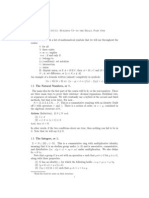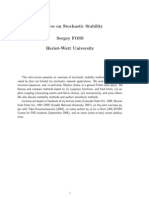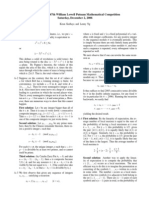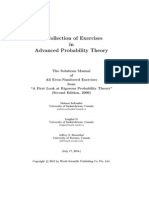Random Variables: 1.1 Elementary Examples
Random Variables: 1.1 Elementary Examples
Uploaded by
jsndacruzCopyright:
Available Formats
Random Variables: 1.1 Elementary Examples
Random Variables: 1.1 Elementary Examples
Uploaded by
jsndacruzOriginal Title
Copyright
Available Formats
Share this document
Did you find this document useful?
Is this content inappropriate?
Copyright:
Available Formats
Random Variables: 1.1 Elementary Examples
Random Variables: 1.1 Elementary Examples
Uploaded by
jsndacruzCopyright:
Available Formats
Chapter 1
Random Variables
1.1 Elementary Examples
We will start with elementary and intuitive examples of probability. The most
well-known example is that of a fair coin: if ipped, the probability of getting
a head or tail both equals to 1/2. If we perform n independent tosses, then the
probability of obtaining n heads is equal to 1/2
n
. In fact, let S
n
= X
1
+ X
2
+
. . . +X
n
, where
X
j
=
_
1 if the result of the n-th trial is a head
0 if the result of the n-th trial is a tail
Then the probability that we get k heads out of n tosses is equal to
ProbS
n
= k =
1
2
n
_
n
k
_
In particular, using Stirling formula, we can calculate the asymptotic of obtain-
ing heads exactly half of the time:
ProbS
2n
= n =
1
2
2n
_
2n
n
_
=
1
2
2n
(2n)!
(n!)
2
e
1/2
n
0,
as n .
On the other hand, since we have a fair coin, we do expect to obtain heads
roughly half of the time, i.e.
S
2n
2n
1
2
,
for large n. Such a statement is indeed true and is embodied in the law of large
numbers that we discuss in the next chapter. For the moment let us simply
observe that while the probability that S
2n
equals to n goes to zero as n ,
the probability that S
2n
is close n goes to 1 as n . More precisely, for any
> 0,
Prob
_
S
2n
2n
1
2
>
_
0,
5
6 CHAPTER 1. RANDOM VARIABLES
as n . This is the weak law of large numbers for this particular example.
In the example of the fair coin, the number of outcomes in an experiment is
nite. In contrast, the second class of elementary examples involve a continuous
set of possible outcomes. Consider the orientation of a unit vector . Denote
by S
2
the unit sphere in R
3
. Dene f(n), n S
2
as the orientation distribution
function, i.e. for A S
2
,
Prob A =
_
A
f(n)d,
where d is the surface area element on S
2
. If does not have a preferred
orientation, i.e. it has equal probability of pointing at any direction, then
f(n) =
1
4
,
On the other hand, if does have a preferred orientation, say n
0
, then we expect
f(n) to be peaked at n
0
.
1.2 Probability Space
It is useful to put these intuitive notions of probability on a rm mathematical
basis, as was done by Kolmogorov. For this purpose, we dene the notion of
probability space, often written as a triplet (, T, P), where is a set called the
sample space and T is a collection of subsets of satisfying the requirements
that
(i) T, T;
(ii) if A T, then
A T, where
A = /A is the complement of A in ;
(iii) if A
1
, A
2
, . . . T, then
nN
A
n
T.
Such a collection of sets is called a -algebra, and the pair (, T) is called a
measurable space. We often use to denote elements in , which call smaple
points, and each set in T is called an event. P : T [0, 1] is the probability
measure or, in short, the probability, dened on T; it satises
(a) P() = 0, P() = 1;
(b) if A
1
, A
2
, . . . T are pairwise disjoint, A
i
A
j
= if i ,= j, then
P(
_
nN
A
n
) =
nN
P(A
n
).
Example 1.2.1 (Fair coin). The probability space for the outcome of one trial
can be dened as follows. = head, tail,
T = all subsets of = , head, tail,
1.3. CONDITIONAL PROBABILITY 7
and
P() = 0, P(head) = P(tail) =
1
2
, P() = 1.
For n tosses, we can take = head, tail
n
, T = all subsets of , and
P(A) =
1
2
n
Card(A),
where Card(A) is the cardinality of the set A.
Within this framework, the standard rule of set theory are used to answer
probability questions. For instance, if both A, B T, the probalility that A and
B occur is given by P(AB), the probability that A or B occur, by P(AB),
the probability that A but not B occur by P(A/B), etc. It is also elementary
to show intuitive properties like
A B P(A) P(B),
since B = A (B/A), implying by (b) above that P(B) = P(A) + P(B/A)
P(B), or
P(A B) P(A) +P(B)
since A = A(B A
c
), implying by (b) above that P(AB) = P(A) +P(B
A
c
) P(A) +P(B). This inequality is known as Booles inequality.
Another useful notion is that of independence. Two events A, B T are
independent if
P(A B) = P(A)P(B).
This generalizes to a sequence A
n
nN
of independent events as
P(
nN
A
n
) =
nN
P(A
n
).
1.3 Conditional probability
Let A, B T and assume that P(B) ,= 0. Then the conditional probability of
A given B is dened as
P(A[B) =
P(A B)
P(B)
.
Clearly this corresponds to the proportion of events where both A and B occur
given that B has occured. For instance, the probability to obtain two tails in
two tosses of a fair coin is
1
4
, but the conditional probability to obtain two tails
is
1
2
given that the rst toss is a tail, and is zero given that the rst toss is a
head.
One has
P([B) = 1,
8 CHAPTER 1. RANDOM VARIABLES
and therefore if A
1
, A
2
, are disjoint sets such that
n
A
n
= , then
n
P(A
n
[B) = 1.
Therefore
P(A
j
[B) =
P(A
j
B)
n
P(A
n
[B)
.
This is known as Bayes rule.
Since P(A B) = P(A[B)P(B) by denition, we also have by iteration
P(A B C) = P(A[B C)P(B[C)P(C),
and so on.
1.4 Discrete Distributions
Making n tosses of a fair coin is an example of an experiment where the total
number of outcomes is nite. More generally, if the number of elements in
= A
1
, A
2
, . . . is nite or enumerable, and associated with each of these
events there is a numerical value, X
j
, the function X such that X(A
j
) = X
j
is called a discrete random variable. It is usually convenient to take simply
X
j
1, 2, . . . , N in the nite case, and X
j
N or X
j
Z in the numerable
case, so that X : 1, 2, . . . , N, X : N, or X : Z, and we will
restrict to these cases. The probability distribution of X is the probability that
X takes the value j, i.e
p(j) = ProbX = j = P(A
j
), j = 1, . . .
and it obviously satises
p(j) 0,
j
p(j) = 1.
(The second conditions also implies that p(j) 1.) Given a function f of X,
its expectation is given by
Ef(X) =
i
f(i)p(i),
if the sum is well-dened. In particular, the pth moment of the distribution is
dened as
m
p
=
j
j
p
p(j),
if the sum is well-dened. The rst moment is also called the mean of the
random variable and is denoted by mean(X). Another important quantity is its
variance dened as
var(X) = m
2
m
2
1
=
j
(j m
1
)
2
p(j).
1.5. CONTINUOUS DISTRIBUTIONS. 9
Exercise 1.4.1. S
n
, the number of head in an outcome of n tosses, is an example
of random variable with a distribution is given by
p(j) = ProbS
n
= j =
1
2
n
_
n
j
_
.
Show that the mean and the variance of this random variable are
mean(X) =
n
2
, var(X) =
n
4
,
implying that var(X)/(mean(X))
2
0 as n .
Poisson distribution. This is the simplest example for the distribution of
randomly scattered points. Consider a set of randomly scattered points on the
plane. Let A be a set in R
2
. X
A
() be the number of points in A. X
A
has
Poisson distribution if
PX
A
() = n =
n
n!
e
,
where may depend on A according to the density of the points. If the points
are uniformly distributed on the plane, then is equal to the area of A. Notice
that in this case
= mean(X
A
) = var(X
A
).
1.5 Continuous Distributions.
Consider now the general case when is not necessarily numerable. A function
X : R
n
is called a random variable on the probability space (, T, P) if
the set : X() U is in T for all open set U R
n
. The distribution of
the random variable X is a probability measure on R
n
, dened for any set
B R
n
by
(B) = ProbX B = P : X() B.
If there exists an integrable function (x) such that
(B) =
_
B
(x)dx,
then is called the probability density of X.
Given its distribution, the expectation of f(X) is dened as
Ef(X) =
_
R
n
f(x)(dx),
if f is continuous and the right hand is well-dened (i.e.
_
R
n
[f(x)[(dx) < ).
Two important expectation are the mean of X,
mean(X) = EX,
10 CHAPTER 1. RANDOM VARIABLES
and the variance of X,
var(X) = E
_
(X EX)(X EX)
T
_
.
The expectation of f(X) can also be written as
Ef(X) =
_
f(X())dP(),
which allows us to make connection with L
p
-space. For p 1 let
L
p
= L
p
(, T, P) = X() : E[X[
p
< .
Then L
p
is a Banach space with norm
|X|
p
= (E[X[
p
)
1/p
,
and L
2
is a Hilbert space with scalar product
X, Y ) = E(X, Y ),
where (X, Y ) denotes the standrad scalar product in R
d
. In L
2
, we have
Scwartzs inequality
E[(X, Y )[ |X|
2
|Y |
2
.
More generally, we have Holders inequality
E[(X, Y )[ |X|
p
|Y |
q
, p > 1, 1/p + 1/q = 1, X L
p
, Y L
q
.
The triangle inequality in L
p
is called Minkowskis inequality
|X +Y |
p
|X|
p
+|Y |
p
, p 1, X, Y L
p
.
Exercise 1.5.1 (Jensens inequality). Let X be a one dimensional variable such
that M() = Ee
X
< for some R. Show that
M() e
EX
.
Two random variables X and Y are called independent if
Ef(X)g(Y ) = Ef(X)Eg(Y ),
for all continuous functions f and g. This means that the joint distributions of
X and Y is simply the product measure of the distributions of X and Y , i.e.
(dx, dy) =
x
(dx)
y
(dy).
A weaker notion is the following. X and Y are uncorrelated if
cov(X, Y ) = 0,
where cov(X, Y ) is the covariance matrix of X and Y ,
cov(X, Y ) = E(X EX)(Y EY )
T
.
1.6. EXAMPLES OF CONTINUOUS DISTRIBUTION 11
Exercise 1.5.2. Pairwise independence does not imply independence. Let X, Y
be two independent random variables such that
P(X = 1) = P(Y = 1) =
1
2
,
and let Z = XY . Check that X, Y , Z are pairwise independent but not
independent, i.e.
Ef(X)g(Y )h(Z) = Ef(X)Eg(Y )Eh(Z),
does not hold for all continuous functions f, g, h.
1.6 Examples of Continuous Distribution
We list a few important continuous distributions.
1. Uniform distribution
(x) =
_
_
_
1
vol(B)
if x B
0 otherwise
In one dimension for B = [0, 1] this reduces to
(x) =
_
1 if x [0, 1]
0 otherwise
Pseudo-random numbers generated on the computer typically have this distri-
bution.
2. Exponential distribution
(x) =
_
0 if x < 0
e
x
if x 0
Special cases include the distribution of waiting time for continuous time Markov
process ( is the rate of the process) and the Boltzmann distribution
f(E) =
_
e
E
if E 0
0 if E < 0,
where = 1/k
B
T, k
B
is the Boltzmann constant, and T is the temperature.
12 CHAPTER 1. RANDOM VARIABLES
3. Normal distribution
(x) =
e
1
2
(x x)
T
A
1
(x x)
(2)
n/2
(det A)
1/2
,
where A is a symmetric positive denite matrix, det A is the determinant of A;
x is the mean, A is the variance, and the random variable with the density above
is denoted by N( x, A). Such random variables are also called Gaussian random
variables. In dimension one, the density of a normal variable reduces to
(x) =
e
(x x)
2
/2
2
2
2
,
where x is the mean,
2
is the variance.
Exercise 1.6.1. Let X = (X
1
, . . . , X
n
) be a n-dimensional Gaussian random
variable and let Y = c
1
X
1
+c
2
X
2
+ +c
n
X
n
, where c
1
, . . . , c
n
are constants.
Show that Y is also Gaussian.
1.7 Conditional Expectation
The concept of conditional probability extends straightforwardly to discrete ran-
dom variables. Let X and Y be two discrete random variables, not necessarily
independent, with joint probability
p(i, j) = P(X = i, Y = j).
Since
i
p(i, j) = P(Y = j), the conditional probability that X = i given that
Y = j is given by
p(i[j) =
p(i, j)
i
p(i, j)
.
if
i
p(i, j) > 0 and conventionaly taken to be zero if
i
p(i, j) = 0. From this,
the natural denition of the conditional expectation of f(X) given that Y = j
is
E(f(X)[Y = j) =
i
f(i)p(i[j).
A diculty arises when one tries to generalizes this concept to continuous
random variables. Indeed, given two continuous random variables X and Y with
joint probability density (dx, dy), the probability that Y = y is zero for most
values of y. Therefore, the ratio involved in the denition of the conditional
probability measure is not dened. An obvious way to try to x this problem is
to take limits, i.e. dene the conditional probability of X B given that Y = y
as
(B[y) = lim
0
(B, B
(y))
_
R
n
(dx, B
(y))
,
1.8. BOREL-CANTELLI LEMMA 13
where B
(y) is the ball of radius centered around y. However, requiring that
this limit exists for every y turns out to be very restrictive, and it is better to
proceed dierently.
The is done as follows. One says that a measure is absolutely continuous
with rescpect to a measure , which is denoted as , if for every open set B
such that (B) = 0, one also has (B) = 0. It can be shown that when ,
there exists a function (z) such that for any B,
(B) =
_
B
(z)(dz).
The function is unique up to equivalence, i.e. it can be modied at most on
a set of zero measure with respect to (dz), and it is called the Radon-Nikodym
derivative of with respect to . This is denoted as
=
d
d
.
Note that within this terminology, the fact that has a density (z) means
that is absolutely continuous with respect to the Lesbegue measure dz, with
Radon-Nykodym derivative (z).
The conditional probability of x B knowing that Y = y, which we denote
as (B[y), can be dened as the Radon-Nikodym derivative of (dx, dy) with
respect to
y
(B) =
_
R
n
(dx, B) (the marginal probability of Y ), i.e. it satises
for every open sets A, B
(A, B) =
_
B
(A[y)
y
(dy).
Thus (A[y) is only dened up to a set of measure zero with respect to
y
(dy),
which is ne in practice and is why this denition is less restrictive than the one
above in terms of limit. If the pair (X, Y ) has a density, (x, y), then
(A[y) =
_
A
(x, y)
(y)
dx,
where (y) =
_
R
n
(x, y)dx is the marginal density of Y .
1.8 Borel-Cantelli Lemma
Many questions in probability, like the convergence of the normalized sum of
independent variables to their mean (i.e the law of large number treated below),
involve tail event. A tail event is an event dened on a sequence of events,
say A
n
n=N
, which is such that its probability do not depends on the rst
A
1
, . . . , A
k
no matter how large k is. For instance if S
n
/n is the proprtion of
heads in n tosses of a fair coin, the event that S
n
/n 1/2 as n is a tail
event because the probability that
S
n
n
=
1
n
n
j=1
X
j
1
2
14 CHAPTER 1. RANDOM VARIABLES
is the same as the probability that
1
n
n
j=k
X
j
1
2
for any k 1.
An important example of a tail event dened on A
n
nN
is the event that
A
n
occur innitely many otfen, i.e.
A
n
i.o. = : A
n
i.o. = lim
k
_
kn
A
k
=
nN
_
kn
A
k
The probability of such an event is specied by:
Lemma 1.8.1 (Borel-Cantelli Lemma).
1. If
n=1
P(A
n
) < , then PA
n
i.o. = 0.
2. If the A
n
s are independent and
n=1
P(A
n
) = , then PA
n
i.o. = 1.
Proof. 1. P
n=1
k=n
A
k
P
k=n
A
k
k=n
P(A
k
) for any n, but the
last term goes to 0 as n since
k=1
P(A
k
) < by assumption.
2. Using independence, one has
P(
_
k=n
A
k
) = 1 P(
k=n
A
c
k
) = 1
k=n
P(A
c
k
) = 1
k=n
(1 P(A
k
)).
Using 1 x e
x
, this gives
P(
_
k=n
A
k
) 1
k=n
e
P(A
k
)
= 1 e
k=n
P(A
k
)
= 1.
Since the left hand-side is a probability, the bound must be sharp and we are
done.
As an example of application of this result, we prove
Lemma 1.8.2. Let X
n
nN
be a sequence of identically distributed (not nec-
essarily independent) random variables, such that E[X
n
[ < . Then
lim
n
X
n
n
= 0 a.s.,
Here and below a.s. stands for almost surely, i.e. for almost all except
possibly a set of zero probability (see denition 1.9.1).
Proof. For any > 0, dene
A
n
= : [X
n
()/n[ > .
1.8. BOREL-CANTELLI LEMMA 15
Then
n=1
P(A
n
) =
n=1
P[X
n
[ > n
=
n=1
P[X
1
[ > n
=
n=1
k=n
Pk < [X
1
[ (k + 1)
=
k=1
kPk < [X
1
[ (k + 1)
=
k=1
k
_
k<|x|(k+1)
(dx)
k=1
_
k<|x|(k+1)
[x[(dx)
=
1
_
<|x|
[x[(dx)
E[X
1
[ < .
Therefore if we dene
B
= : A
n
i.o.,
then P(B
) = 0. Let B =
nN
B1
n
. Then P(B) = 0, and
lim
n
X
n
()
n
= 0, if , B.
Note that this proof relies on a special case of a useful inequality which we
state as a lemma.
Lemma 1.8.3 (Chebyshevs Inequality). Let X be a random variable such
that E[X[
k
< , for some integer k. Then
P[X[ >
1
k
E[X[
k
,
for any positive constant .
Proof. For any > 0,
E[X[
k
=
_
R
n
[x[
k
(dx)
_
|x|
[x[
k
(dx)
k
_
|x|
(dx) =
k
P[X[ .
16 CHAPTER 1. RANDOM VARIABLES
1.9 Notions of Convergence
Let X
n
n=1
be a sequence of random variables dened on a probability space
(, T, P), and let
n
be the distribution of X
n
. Let X be another random
variable with distribution . We will discuss four notions of convergence: almost
sure convergence, convergence in probability, convergence in distribution, and
convergence in L
p
.
Denition 1.9.1 (Almost sure convergence). X
n
converges to X almost
surely as n , if
P : X
n
() X() = 1.
We express almost sure convergence as X
n
X, a.s.
Denition 1.9.2 (Convergence in probability). X
n
converges to X in prob-
ability if for any > 0,
P : [X
n
() X()[ > 0,
as n .
Denition 1.9.3 (Convergence in distribution). X
n
converges to X in
distribution if for any continuous function f,
Ef(X
n
) Ef(X).
This is denoted as X
n
d
X, or
n
d
, where
n
, are the distributions of
X
n
and X respectively.
Denition 1.9.4 (Convergence in L
p
). Let X
n
nN
be a sequence of ran-
dom variables such that X
n
L
p
. X
n
converges to X L
p
in L
p
(or in pth
mean) if
E[X
n
X[
p
0.
For p = 1 we speak about convergence in mean; for p = 2, convergence in mean
square.
From real analysis, we know that convergence in L
p
implies convergence in L
q
if p q, almost sure convergence implies convergence in probability, convergence
in probability implies that there is a subsequence that converges almost surely,
and convergence in probability implies convergence in distribution. Convergence
in L
p
implies convergence in probability.
1.10 Characteristic Functions
The characteristic function of a probability measure is dened as
f() = Ee
i(,X)
=
_
R
n
e
i(x,)
(dx).
It has the following obvious properties
1.10. CHARACTERISTIC FUNCTIONS 17
1. R
n
, [f()[ 1, f() = f();
2. f is uniformly continuous on R
1
.
We also have
Theorem 1.10.1. Let
n
nN
be a sequence of probability measures, and
f
n
nN
be their corresponding characteristic functions. Assume that
1. f
n
converges everywhere on R
n
to a limiting function f.
2. f is continuous at = 0.
Then there exists a probability distribution such that
u
d
. Moreover f is
the characteristic function of .
Conversely, if
n
d
, where is some probability distribution then f
n
converges to f uniformly in every nite interval, where f is the characteristic
function of .
For a proof, see [2]
As in Fourier transforms, one can also dene the inverse transform
(x) =
1
(2)
n
_
R
n
e
i(,x)
f()d.
An interesting question arises as to when this gives the density of a probability
measure. To answer this we dene
Denition 1.10.1. A function f is called positive semi-denite if for any nite
set of values
1
, . . . ,
n
, n N, the matrix (f(
i
j
)) is positive semi-denite,
i.e.
i,j
f(
i
j
)v
i
v
j
0,
for any v
1
, . . . , v
n
.
Theorem 1.10.2 (Khinchin). If f is a positive semi-denite uniformly contin-
uous function and f(0) = 1, then it is the characteristic function of a probability
measure.
Exercise 1.10.1 (Stable laws). A one-dimensional distribution (dx) is stable if
given any two independent random variables X and Y following this distribu-
tion, there exists a and b such that
a(X +Y b)
has distribution (dx). Show that f() = e
||
is the characteristic function
of a stable distribution for 0 2, and is not a characteristic function for
other values of .
Exercise 1.10.2 (Girkos circular law for random matrices). If A has i.i.d. entries
with mean zero and variance
2
, then the eigenvalues of A/
n are asymptot-
ically uniformly distributed in the unit disk in the complex plane. Investigate
numerically.
18 CHAPTER 1. RANDOM VARIABLES
You might also like
- English Grammar For Competitive Exams Free Download PDFDocument169 pagesEnglish Grammar For Competitive Exams Free Download PDFDecent Decor100% (1)
- Vaughan's Lecture Notes On Real AnalysisDocument76 pagesVaughan's Lecture Notes On Real AnalysispriannaNo ratings yet
- John Fowles A Maggot PDFDocument265 pagesJohn Fowles A Maggot PDFEliza Filimon100% (1)
- Abilix Eduacational Robot Brick Series Krypton 1,2 User ManualDocument17 pagesAbilix Eduacational Robot Brick Series Krypton 1,2 User ManualemmanuelNo ratings yet
- Probability Theory: 1 Heuristic IntroductionDocument17 pagesProbability Theory: 1 Heuristic IntroductionEpic WinNo ratings yet
- Introduction To Financial MathematicsDocument47 pagesIntroduction To Financial MathematicsTu ShirotaNo ratings yet
- Foss Lecture1Document32 pagesFoss Lecture1Jarsen21No ratings yet
- Stochastic Processes NotesDocument22 pagesStochastic Processes Notesels_872100% (1)
- MA2216 SummaryDocument1 pageMA2216 SummaryKhor Shi-Jie100% (1)
- Solutions To The 67th William Lowell Putnam Mathematical Competition Saturday, December 2, 2006Document8 pagesSolutions To The 67th William Lowell Putnam Mathematical Competition Saturday, December 2, 2006Ganesh KumarNo ratings yet
- Probability ReviewDocument5 pagesProbability Reviewravcha19No ratings yet
- 2 PDFDocument27 pages2 PDFKaushiki SenguptaNo ratings yet
- Probability Theory Nate EldredgeDocument65 pagesProbability Theory Nate Eldredgejoystick2inNo ratings yet
- Probability 2024Document14 pagesProbability 2024Nizam AzhanNo ratings yet
- BechorDocument8 pagesBechorEpic WinNo ratings yet
- Lecture Notes Week 1Document10 pagesLecture Notes Week 1tarik BenseddikNo ratings yet
- CoPM Lecture1Document17 pagesCoPM Lecture1fayssal achhoudNo ratings yet
- Durett Radon Nikodym Exercsises With SolnDocument10 pagesDurett Radon Nikodym Exercsises With SolnKristian MamforteNo ratings yet
- RV IntroDocument5 pagesRV IntroBalajiNo ratings yet
- Definition 4.1.1.: R Then We Could Define ADocument42 pagesDefinition 4.1.1.: R Then We Could Define AAkshayNo ratings yet
- Joint Random Variables 1Document11 pagesJoint Random Variables 1Letsogile BaloiNo ratings yet
- 1 Introduction To Information TheoryDocument9 pages1 Introduction To Information TheoryPooja BiswasNo ratings yet
- A Probabilistic Theory of Pattern Recognition: Based On The Appendix of The TextbookDocument4 pagesA Probabilistic Theory of Pattern Recognition: Based On The Appendix of The Textbookpineappleshirt241No ratings yet
- Class6 Prep ADocument7 pagesClass6 Prep AMariaTintashNo ratings yet
- Exam1_10Document3 pagesExam1_10Sambsamb SambianiNo ratings yet
- Unit 8 ProbabilityDocument9 pagesUnit 8 ProbabilityAaron PowellNo ratings yet
- Spring School StochasticDocument14 pagesSpring School StochasticStiven Diaz FlorezNo ratings yet
- Introductory Probability and The Central Limit TheoremDocument11 pagesIntroductory Probability and The Central Limit TheoremAnonymous fwgFo3e77No ratings yet
- A B P (B) P (A: Multiplication Law. Let and Be Events and Assume - ThenDocument20 pagesA B P (B) P (A: Multiplication Law. Let and Be Events and Assume - ThenGanesh SainathNo ratings yet
- Probab RefreshDocument7 pagesProbab RefreshengrnetworkNo ratings yet
- More Discrete R.VDocument40 pagesMore Discrete R.VjiddagerNo ratings yet
- Probability Theory (MATHIAS LOWE)Document69 pagesProbability Theory (MATHIAS LOWE)Vladimir MorenoNo ratings yet
- FormulaDocument6 pagesFormulachinthabhavitha24No ratings yet
- STAT 333 Assignment 1 SolutionsDocument6 pagesSTAT 333 Assignment 1 SolutionsliquidblackoutNo ratings yet
- AnL P Inequality For PolynomialsDocument10 pagesAnL P Inequality For PolynomialsTanveerdarziNo ratings yet
- Finite Probability Spaces Lecture NotesDocument13 pagesFinite Probability Spaces Lecture NotesMadhu ShankarNo ratings yet
- Probability Laws: Complementary EventDocument23 pagesProbability Laws: Complementary EventalvinhimNo ratings yet
- Lect 02Document12 pagesLect 02匡政No ratings yet
- Stochastic LecturesDocument8 pagesStochastic LecturesomidbundyNo ratings yet
- Chapter 2 PatternDocument21 pagesChapter 2 PatternSumit Kumar DamNo ratings yet
- Binomial and Related DistributionsDocument17 pagesBinomial and Related DistributionsU. AjazNo ratings yet
- Chap2 PDFDocument20 pagesChap2 PDFJacobNo ratings yet
- Lecture 4 - Fall 2023Document29 pagesLecture 4 - Fall 2023tarunya724No ratings yet
- Asymtotic BehaiorDocument169 pagesAsymtotic BehaiorLuis ValerinNo ratings yet
- Lecture Notes 2 1 Probability InequalitiesDocument9 pagesLecture Notes 2 1 Probability InequalitiesHéctor F BonillaNo ratings yet
- Information Theory and CodingDocument79 pagesInformation Theory and CodingPrasun DasNo ratings yet
- EC221 Principles of Econometrics Solutions PSDocument6 pagesEC221 Principles of Econometrics Solutions PSslyk1993No ratings yet
- Discrete Random VariableDocument13 pagesDiscrete Random VariableFierda Kurnia CapNo ratings yet
- The Geometric Distribution: P (X I) Q PDocument5 pagesThe Geometric Distribution: P (X I) Q Psuchi87No ratings yet
- Notes 3Document5 pagesNotes 3thinhNo ratings yet
- 6300 SolutionsmanualDocument89 pages6300 SolutionsmanualEhssan GhashimNo ratings yet
- Alternating Group & Parity of PermutationsDocument11 pagesAlternating Group & Parity of PermutationsArjun BanerjeeNo ratings yet
- Instructor: DR - Saleem AL Ashhab Al Ba'At University Mathmatical Class Second Year Master DgreeDocument13 pagesInstructor: DR - Saleem AL Ashhab Al Ba'At University Mathmatical Class Second Year Master DgreeNazmi O. Abu JoudahNo ratings yet
- Probability Review 2023Document40 pagesProbability Review 2023Pablo DiegoNo ratings yet
- Probability Formula SheetDocument11 pagesProbability Formula SheetJake RoosenbloomNo ratings yet
- Some Common Probability DistributionsDocument92 pagesSome Common Probability DistributionsAnonymous KS0gHXNo ratings yet
- SST 204 Courtesy of Michelle OwinoDocument63 pagesSST 204 Courtesy of Michelle OwinoplugwenuNo ratings yet
- Convolution and Equidistribution: Sato-Tate Theorems for Finite-Field Mellin TransformsFrom EverandConvolution and Equidistribution: Sato-Tate Theorems for Finite-Field Mellin TransformsNo ratings yet
- National Science Olympiad: Sample PaperDocument4 pagesNational Science Olympiad: Sample PaperYan YanNo ratings yet
- 2018-2019 ESSAY Screen EntertainDocument1 page2018-2019 ESSAY Screen Entertainana martinez jimenezNo ratings yet
- LIST OF 40+ AI Marketing ToolsDocument15 pagesLIST OF 40+ AI Marketing ToolsAbhrajyoti ChowdhuryNo ratings yet
- Building Energy Management SystemDocument11 pagesBuilding Energy Management SystemPlacid FabiloNo ratings yet
- ED Tox PGS.2021Document4 pagesED Tox PGS.2021Jm uniteNo ratings yet
- Friends Analysis PDFDocument2 pagesFriends Analysis PDFRoronoa ZoldyckNo ratings yet
- Jenness v. Fortson, 403 U.S. 431 (1971)Document10 pagesJenness v. Fortson, 403 U.S. 431 (1971)Scribd Government DocsNo ratings yet
- Banana FiberDocument9 pagesBanana FibershaluNo ratings yet
- Drama NotesDocument44 pagesDrama NotescheptorusvildaNo ratings yet
- Resume of SEO ExecutiveDocument2 pagesResume of SEO ExecutiveKiranKumarSivalaNo ratings yet
- AS Economics Essay Questions PracticeDocument9 pagesAS Economics Essay Questions PracticeEduardo SanchezNo ratings yet
- HU Criminology and Forensic ScienceDocument10 pagesHU Criminology and Forensic Sciencebshee83No ratings yet
- 4 5triangle Congruence ASA AAS HLDocument28 pages4 5triangle Congruence ASA AAS HLMyca Antonette Yza CordovaNo ratings yet
- Model Q - Structural Grammar and Spoken EnglishDocument9 pagesModel Q - Structural Grammar and Spoken EnglishIkshavakuNo ratings yet
- 738 Buggy PlansDocument15 pages738 Buggy Plansstevenmojicaa7No ratings yet
- 17.maxillary Sinus Floor Elevation For Implant Placement Assisted by An Autonomous Dental Implant Robotic System A Clinical ReportDocument7 pages17.maxillary Sinus Floor Elevation For Implant Placement Assisted by An Autonomous Dental Implant Robotic System A Clinical Reportyakebot0930No ratings yet
- Downloaded From Manuals Search Engine: 09/2011 Melitta Haushaltsprodukte GMBH & Co. KG D-32372 MindenDocument39 pagesDownloaded From Manuals Search Engine: 09/2011 Melitta Haushaltsprodukte GMBH & Co. KG D-32372 MindenKrasimir NikiforovNo ratings yet
- 3 Philconsa v. Mathay - 18 SCRA 300Document33 pages3 Philconsa v. Mathay - 18 SCRA 300Bee CGNo ratings yet
- Ethernet Crossover Cable - DIY How-To GuideDocument2 pagesEthernet Crossover Cable - DIY How-To GuidexxxxxxxxxxxxxxxxxxxxNo ratings yet
- Inseguridad Alimentari Bolivia 2021 - LAPOP - AmericasBarometer - 2021 - Pulse - of - DemocracyDocument112 pagesInseguridad Alimentari Bolivia 2021 - LAPOP - AmericasBarometer - 2021 - Pulse - of - DemocracyAlvaro MontoyaNo ratings yet
- Salame Coppata - Also Called Salame Veneziana (Venetian Salami)Document2 pagesSalame Coppata - Also Called Salame Veneziana (Venetian Salami)NikoNo ratings yet
- JESD22-B111-Board Level Drop Test-2003-07Document22 pagesJESD22-B111-Board Level Drop Test-2003-07memstec1111No ratings yet
- NOVAX Hair Care - PresentationDocument14 pagesNOVAX Hair Care - PresentationJudy LavyNo ratings yet
- Metalux ResidentialDocument16 pagesMetalux ResidentialRAUL354No ratings yet
- CwheelsSteelWheelsNov25 2016Document76 pagesCwheelsSteelWheelsNov25 2016Cynthia LiNo ratings yet
- Valentines Day Color Coding ProposalDocument3 pagesValentines Day Color Coding ProposalBryce BajadoNo ratings yet
- 0028 KJ Emails PDFDocument1,291 pages0028 KJ Emails PDFNickMillerNo ratings yet

























































































